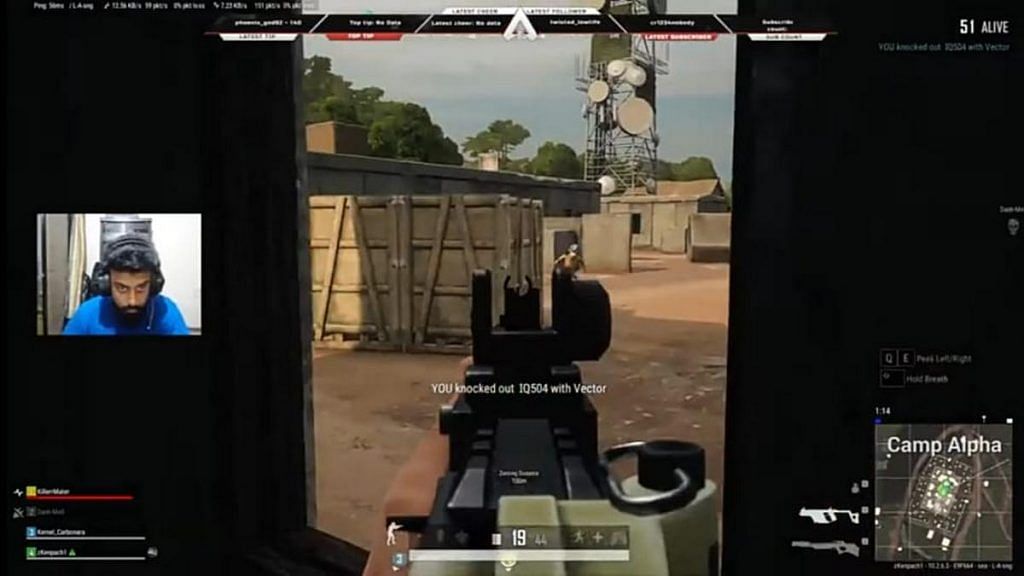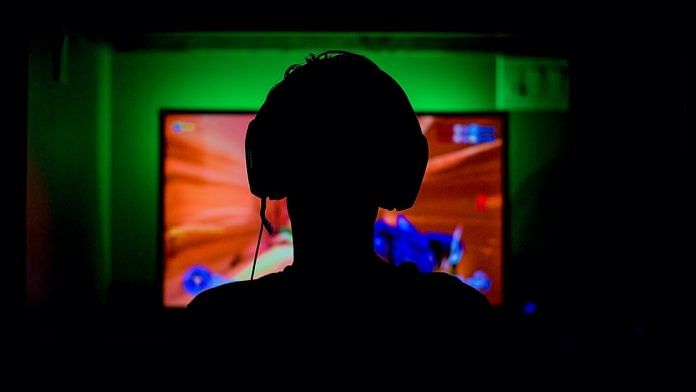New Delhi: Vishnu Menon, 29, is a classic example of a gig worker, with multiple streams of income. One of them is gaming on YouTube and Twitch. Just a few years ago, he might have been accused of “wasting time” or asked to get “a real job”, but post the Covid-19 pandemic, perceptions about gaming are changing in India, and the industry’s prospects are looking brighter than ever.
With the pandemic restricting social interactions and other activities, many Indians looked to gaming to fulfil their needs for connecting — and competing — with others.
So often associated with isolation and disconnection, gaming is now increasingly being seen as a way to increase connection and participation in the world. Indeed, India now has professional gamers who compete, and earn, globally through teams that come complete with a coach, fitness instructor, and agent.
In 2021, the online gaming segment in India grew 28 per cent to reach Rs 101 billion or 10,100 crore (approximately US$1.3 billion), according to a report published in March 2022 by EY, a global professional services company, and the Federation of Indian Chambers of Commerce & Industry (FICCI).
The transformation is such that the gaming industry is staring at a boost to over US$2 billion in 2023 from US$906 million in 2019, according to another forecast by the All-India Gaming Federation (AIGF) and EY.
“The Covid-19 pandemic was a test of the sector’s robustness and determination to grow despite the constraints,” Roland Landers, CEO of the AIGF, which is the apex body of the industry in India, told ThePrint on e-mail. “The Indian online gaming industry has seen a prominent rise in the number of users, revenue, and investments.”
Also Read: ‘Online games of skill fall under freedom of speech & expression’: Why HC junked Karnataka ban
An antidote to lockdowns
Online games were a source of relief and release to millions of people the world over who were going stir-crazy during lockdowns. Unsurprisingly, gaming revenues also saw a massive boost.
Microsoft’s gaming revenue, for instance, increased 50 per cent for the quarter ending in March 2021; the company also noted that its Xbox Series X and S, launched in November 2020, witnessed “demand that significantly exceeded supply”.
With the huge uptick in gaming, even the WHO saw it fit to relay messages about health and fitness through tie-ups with gaming companies. India was part of the worldwide trend.
The EY and FICCI report noted that online gamers grew by 8 per cent to 390 million from 360 million in 2020, although the “daily player range” was 90-100 million.
Tier-III cities were a major driver of this growth, with the top 30 tier-III cities “reporting an increase of 170 per cent of gamers in 2020,” the report read.
The report attributed the surge in gamers to “increased work-from-home and school from home” due to the pandemic and “the consequent build-out of the laptop and mobile phone ecosystem”.
In the midst of an isolating period of time, gaming provided a social respite to many people.
Suromitra Basu, a 30-year-old from Kolkata who was a professional gamer until 2011, said there had always been a “community aspect” to gaming, but it changed form during the pandemic.
“When I was young and I started playing Counterstrike at local cafes, I met many youngsters whose wavelengths matched mine. It was also about spending time with them. In a similar way, gaming is contributing now in building virtual communities and providing support to players who may have been locked within the four walls,” he said.
From entertainment to earning
Many players in India are viewing gaming not just as an avenue for entertainment and connection, but also as a way of earning during economic uncertainty.
Vishnu Gopinath, a 30-year-old from Delhi, told ThePrint how gaming helped him broaden his horizons and also earn some cash at a time when job prospects dwindled due to the pandemic.
“I played on Twitch, which is one of the platforms where gamers can potentially earn money. I earned some Rs 10,000-15,000 and I also interacted with people from different countries including Australia, the Philippines, South Korea, Pakistan, and Ukraine,” he said.
Gopinath added that he is “grateful” that he had access to gaming. “It helped during the time I needed to hunt for a financial alternative to keep myself afloat. This was a good side hustle for me and I found like-minded people who are now my friends,” he said.
However, gaming still doesn’t qualify as a prospective “full-time” job even for players who earn some cash.
Vishnu Menon, mentioned at the beginning of this report, uses his earnings to supplement what he makes in another part-time job.

“I work part-time because earning through gaming full-time is not possible,” he said, adding that he sees this changing.
“I do believe that the day is not far when we would not really have to search for another part-time gig. The pace at which the change in technology is taking place is massive. It is slowly becoming more user-friendly, the graphics are better and the revenue model is also becoming more lucrative. The future is indeed bright,” he said.
Evolution of competitive gaming
Gaming started taking off in India in the early 2000s, and also became popular as a competitive activity in college sports. In the late 2010s, tech companies like Samsung, ASUS, OnePlus, and Xiaomi gave a boost to the industry and started sponsoring players too.
Suromitra Basu has witnessed the transformation first-hand.
“IIT-Kharagpur’s spring fest was one of the most prestigious gaming tournaments in India when I was a player. The prize pool was Rs 2.5 lakh and that was a big deal,” he said. Back then, though, players had to “struggle” to get the right equipment and to meet travel expenses. That is changing, he added.
From small-time tournaments in colleges, the gaming industry has shifted to organising big-scale events in different cities where teams have coaches, agents, and even fitness instructors responsible for the physical well-being of the players.
To keep up with these trends, online game development teams also have to stay agile.
Aditya Upadhyay, who works for Mobile Premier League, an e-sports and mobile gaming platform, said the industry is more geared than ever to what audiences want.
“The difficulty levels, the number of hours that a player can play, recharge features to introduce breaks, improving graphic quality… There are a few regular conversations that take place in my office,” he said, adding that developers must keep different target groups in mind.
“We have to be sensitive to the players and how they are rapidly changing with age,” he said. “Unlike when it all started in the 2000s, we now also have younger players who earn [from gaming].”
The future of gaming in India
India is currently the fourth-largest online gaming market worldwide, according to the AIGF-EY report, and, with cheaper access to devices and games, it is only expected to grow.
According to a November 2021 report by Boston Consulting Group and Sequoia India, mobile gaming is expected to “triple” to an over US$5 billion “market opportunity” by 2025. The report says the user base is expected to cross 300 million, which will lead to companies ramping up their spends in the sector.
The March 2022 report by EY and FICCI cited earlier noted that so far, 94 per cent of “casual gamers” in India used mobile phones to play, but also that the number of e-sports players doubled to 600,000 in 2021 from 300,000 in 2020.
Real money gaming comprised over 70 per cent of segment revenues, the report said, with transaction-based games like rummy and fantasy sports witnessing a 26 per cent increase in revenue.
Landers, too, said that while India is primarily a “smartphone-first market”, players are now “branching out beyond handheld devices”.
“With about 9.33 billion games downloads in recent years, the gaming industry has begun to grow significantly in India,” Landers noted, adding that the industry could become an important employer in the years to come.
“The industry currently employs over 40,000 people in direct jobs and by 2024 the online skill gaming industry is expected to employ around 2 lakh people. It will be bringing in massive employment, through direct and indirect jobs,” he claimed.
(Edited by Asavari Singh)
Also Read: #GenerationNowhere: India’s young are fighting an invisible epidemic, smartphone addiction



